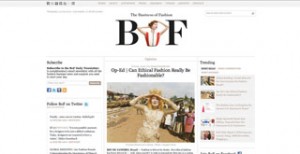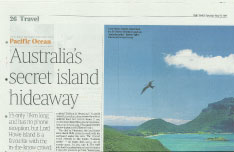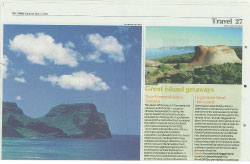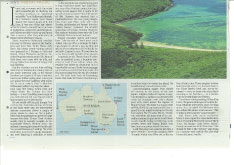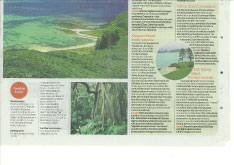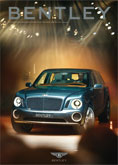Op-Ed | Can Ethical Fashion Really Be Fashionable?
The Business of Fashion | 8th June 2012
by Marion Hume
RIO DE JANEIRO, Brazil — Fashion is driven by desire. But ethical fashion has been driven by — well, what exactly? A wish to semaphore that one is a caring kind of person while walking through life in pleather shoes? There are, of course, style-setters so chic they can rock a hand-loomed yak hair poncho, being good while looking great. The writer is not one of those people.
The writer is, however, a veteran of more than 25 years on the front lines of fashion, possessed of a deep hatred of waste which jars, somewhat, with a love of glamour. Thus, when “green” fashion started to attract attention, I admired the effort but the results just didn’t chime. Ditto those “pity purchase” ranges, created by supermodels, to which I was often allergic because the products weren’t super enough.
This is not to suggest that all supermodel endeavours are empty. Lily Cole and Liya Kibede spring to mind as two whose deep commitment is tangible.
But overall, I am yet to meet the woman who opens her wardrobe in the morning and declares with glee, “Today I want to look ethical.” Most of us, let’s be honest, just want to look as good as we can, add accessories and get out of the house.
Is the tote I’m slinging my laptop into made with fair labour? Is the black t-shirt I have on under my jacket organic cotton? Have all environmental concerns been checked? Nope, not going to happen at 8am. What about getting up to speed at point of purchase instead? No again. A bristling of swing tags, trumpeting good deeds, can be really annoying when they catch in your underwear in the fitting room.
It is my absolute belief that ethical goods have to appeal, even if you don’t know the back story, but, on the flip side, that the fashion goods we desire should be made in the most ethical way possible. Why not? Why shouldn’t sustainability be as central to style as silhouette? Why should it be hard to stride forth in the confidence that you are doing no harm to people or planet?
Maybe the answer lies in Corporate Social Responsibility (CSR) programmes, if only we could be bothered to read those documents companies typically post online. Actually, I do bother. But I find that despite all the moody images of spring leaves and footprints in the sand, CSR brochures tend to muddy the pure blue water — not with what is written, but what is left out. The “light industry” that is fashion can be far from transparent.
So here’s some good news: a rather unusual bunch of bright people are about to get together to grapple with making fashion better. At the end of next week, on June 17th, just before presidents, prime ministers and other world leaders meet in Rio de Janeiro to agree on a way forward for sustainable development, the United Nations Global Compact will host the Rio+20 Corporate Sustainability Forum. Within more than 60 sessions focused on key sustainability issues, there is one that, perhaps, you would not normally expect: “Good Business Models for a Sustainable Future” organized by the International Trade Centre’s Ethical Fashion Initiative. Its focus? Clothes, bags, shoes.
Speakers at this fashion session will include an immaculately dressed Brazilian theologian, Leonardo Boff and a Fendi with an obsession for plastic carrier bags — or, more accurately, an obsession with how to reduce the mountains of them leaching carcinogenic dioxins into hotchpotch neighbourhoods of the world’s poorest people.
The session aims to demonstrate that it is, indeed, very possible to do good while making profits. Joining Boff and Ilaria Venturini Fendi will be Aminata Traore, who hails from Mali, dresses to turn heads and advocates for making the global use of cotton more fair, alongside Auret van Heerden, president of non-profit group Fair Labor Association, whose political consciousness was forged in opposition to apartheid in his native South Africa. Then there’s the American, Willa Shalit, who, by treading softly, continues to lead some of fashion’s biggest names through the complex challenges of working in Haiti.
But the purpose of all this goes beyond letting some people with good accessories vent for an afternoon. The stated aim of the session is to produce a “roadmap” — free to use — to help big global fashion business become more fair, more green, more inclusive yet never less chic. The panel will be led by Simone Cipriani, who helms the Ethical Fashion Initiative of the International Trade Centre (ITC), a United Nations agency for which (disclosure) I have been a consultant since 2009.
How this growing force for ethical fashion differs from others is that Cipriani’s instruction was to conceive a major initiative that would contribute towards two key priorities of the UN: eradicating extreme poverty and empowering women.
He could have said, “let’s open a factory to make tractors.” Instead he said, “I must call Vivienne Westwood.”
We are in Kenya, mid afternoon. After a long drive, there is a longer march to a squatter village, as the community we are visiting have lost their ancestral home to a land grab. The singing of Maasai women acts as an aural navigator.
The matriarch appears first, having donned her finery, adding a towering beaded headdress to her usual daywear collars and cuffs. Vivienne Westwood also dresses for the occasion, ducking into a goat-pen to slip on sky-high rocking horse shoes. Thus do two stylish women utterly “get” one another, then get down to business.
The death of animals due to drought had both unsettled this community and increased domestic violence. While it is the first time Westwood has visited, two seasons worth of orders from her company have allowed the local women to restock the animals, restoring pride to their men and some tranquility to their own lives.
Though they belong to a deeply patriarchal society, these women now have economic power. The matriarch makes this clear. How big an increase is there to be on an order for leather cuffs beaded with the word “SEX?” she wants to know. The negotiations conclude with an additional order for beaded bag panels that read “ILOVE CRAP.” Pure Westwood. Crap, of course, is what this absolutely isn’t.
This is just one small community among many — some rural, some in slums — where lives are being improved by fashion businesses which respond to the real needs of marginalised people. While the fashion world typically thrives on last minute change, this system must be planned in recognition that overtime is not possible in places where, to be safe, women must be home before nightfall. There are also crops to tend, which means that workers might only work three months of the year.
But make no mistake. The impact is real.
Before the orders from Westwood, a key source of income in the village we visit came from the sale of charcoal, which, when burned as fuel, has a devastating consequence in terms of carbon emissions. Dame Vivienne is an ardent advocate against climate change, yet she is amazed; her designs for beaded adornments are having a direct effect of preserving our environment.
Furthermore, Kenyan women typically earn between 150 and 300 Kenyan Shillings (KSH) per day, if they can find work at all. For a Westwood order, for which there is an expectation of high quality, the rate is an average of KSH 600 daily, a substantial increase that translates into quantifiable female empowerment. Indeed, over 70 percent of women working with the Ethical Fashion Initiative now understand banking and have accounts with the Cooperative Bank or the Kenya Women Finance Trust, a microfinance lending institution. And while the Masaai community we visit are squatters, others working for the Ethical Fashion Initiative have been able to use a steady income to rent better accommodation. In another, more settled rural community, the profits from Westwood are evident in a new water tank.
“In all buying, consider first, what condition of existence you cause in the production of what you buy; secondly, whether the sum you have paid is just to the producer and in due proportion lodged in his hand.” So said John Ruskin (1819-1900). But while his words ring true today, a Victorian gent who behaved very oddly towards his wife perhaps isn’t the fashion model we seek. So let’s update and call this “Hermès economics” for not only is the craftsman who makes your Birkin getting a proper pay packet and a hot lunch, but the water downstream of the tannery must be cleaner than the water found upstream.
Transfer that challenge to a tannery in Uganda. When Simone Cipriani was a boy, growing up in Florence, tanneries still pumped unfiltered sludge into the Arno, which made standing on the Ponte Vecchio decidedly whiffy. We wouldn’t tolerate that today. So how to make sure a tannery in Uganda does not discharge water effluents into the mighty Nile at inestimable cost to those living on its banks in several countries? The actual cost of a filtering system is about $10,000 — not insurmountable when factored in as small increments onto the finished cost of a bag, or a shoe.
It’s a myth, in my experience, that fashion people are silly people. Many of us are bright and thoughtful but we’d appreciate some guidance. Hopefully next week’s think tank in Rio will provide that.
Marion Hume is a fashion journalist based in London. For more than two decades, she has written for newspapers and magazines in the US, the UK and Australia.
“Good Business Models for a Sustainable Future” by the International Trade Centre’s Ethical Fashion Initiative will take place June 17th 2012 as part of the Rio+20 Corporate Sustainability Forum, hosted by the United Nations Global Compact.

